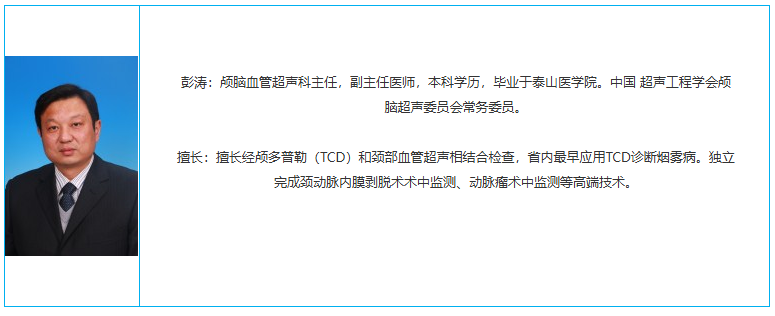- Date:2020-01-08
Our hospital became a base hospital for stroke prevention, control and screening of the Ministry of Health in 2011, and our department has the most advanced equipment platform in the province, keeping with the vascular ultrasound department of Xuanwu Hospital of Capital Medical University, the origin of cranial vascular ultrasonography, and the most professional standing member of the Cranial Cerebral Ultrasound Committee of Chinese Ultrasonographic Engineering Society in the province as the technical platform.
The examination of our department is non-invasive, safe and reproducible, and the conformity rate between the examination results of our Cranio-Cerebral Vascular Ultrasound Department and the results of DSA and other examinations is as high as more than 90 per cent, which reduces the economic burden for the patients.
Cerebrovascular disease is one of the three major causes of human death. With the improvement of people's living standard in China, the problem of population aging is becoming more and more serious, the incidence of cerebrovascular disease in the elderly is increasing, and the incidence of cerebrovascular disease in middle-aged people is also on the rise, especially ischemic cerebrovascular disease accounts for more than 70% of the total number of cases, which is a kind of cerebrovascular disease that can be detected and treated at an early stage.
Carotid ultrasound and cerebrovascular ultrasound detection provide important clinical value for improving the diagnostic accuracy of ischaemic cerebrovascular disease. It not only provides non-invasive detection of advanced means for the localisation of cerebrovascular lesions, but also is a heavy pressure method to carry out the follow-up of the evaluation of the effect of carotid artery stenosis surgery or interventional therapy, and is an easy to be accepted by the patients, less expensive and non-invasive means of detection. The joint application of the two in the clinic can timely and accurately observe the intracranial and extracranial arterial haemodynamic changes produced by ischemic vascular disease, and provide reliable and objective imaging and haemodynamic bases for the clinical selection of different treatments and the obtaining of effective therapeutic effects.
Department Tel: 0635-2342369




 鲁ICP备11009722号-4
鲁ICP备11009722号-4 